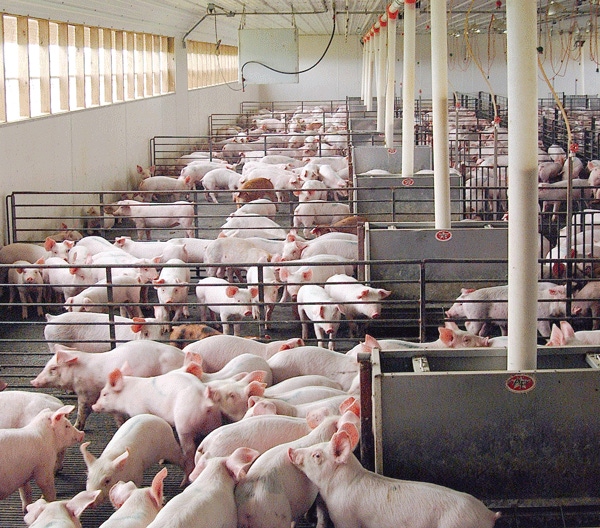
Hog price peak coming soon?
• These may be the highest hog prices for the next several years as well, especially if corn and soybean shortages can be reduced somewhat this summer with favorable growing conditions.• On the other hand, if 2011 turns out to be a short crop production year, then the previous statement will be invalid as surging feed prices will force added liquidation of the hog herd this fall.
March 29, 2011

The highest hog prices on record will soon be arriving. These may be the highest hog prices for the next several years as well, especially if corn and soybean shortages can be reduced somewhat this summer with favorable growing conditions.
On the other hand, if 2011 turns out to be a short crop production year, then the previous statement will be invalid as surging feed prices will force added liquidation of the hog herd this fall. But, you already knew how much was riding on upcoming crops.
USDA’s March Hogs and Pigs report implied that pork supplies will be somewhat higher this year. However, demand factors are more important to hog prices now than supply. Those demand factors include the continued strong growth in export demand, the continued economic recovery in the U.S., and inflation in commodities.
The report indicated the market herd was up nearly one percent, primarily as a result of a somewhat larger than expected winter pig crop. This means pork production will likely be up somewhat over one percent in 2011.
The breeding herd was also up modestly compared to year ago numbers. This is the first time since March 2008 that the breeding herd increased. The herd has been in decline for the last three years as producers were adjusting the herd due to high feed prices and large financial losses.
Producers indicated intentions to reduce farrowings by three percent this spring and again this summer. If producers follow through with these intentions, the size of the fall and winter pig crops will be smaller once again. North Carolina has seen the largest reduction of the breeding herd over the past three years, accounting for about 40 percent of the national reduction. In contrast, the combined states of Minnesota, Iowa, and Missouri have accounted for only 24 percent of the decline.
Demand has recovered
Pork producers have been forced by poor economics to reduce the herd so they can pay higher prices for feed. In addition, demand has recovered from the recession in late 2008 and 2009. USDA now expects pork exports to rise by 11 percent for the year. Actual pork exports for the limited data available for 2011 have been up 17 percent so far.
Japan, the No. 1 U.S. pork customer who purchased 30 percent of all U.S. exports in 2010, will likely need more U.S. pork due to disruptions from their unfolding nuclear disaster. Strong exports mean less of the U.S. production will be available for U.S. consumers and domestic per capita supplies of both pork and beef will be down this year.
Both hog and cattle prices have been on a missile headed upward. What can change this assent? Anticipated inflation probably has continued to play into the strong futures prices for lean hogs and live cattle as the U.S. Federal Reserve continues an easy monetary policy through June. However, there is increasing thought the FED may not continue with that policy after June and this raises increased concern for lean hog and live cattle futures to maintain current lofty levels.
Secondly, retail prices of both pork and beef may become the factor that limits the upside potential of futures as they may reach levels where consumers begin to reduce purchases. My current forecast is that retail beef prices may move to $4.90 a pound this year, up from $4.40 last year, an 11 percent surge.
Pork prices are expected to reach $3.40 a pound this year compared to $3.11 last year, a nine percent increase. Retail prices will move up sharply this summer and that is when some consumer push-back may be noted. Lean hog futures have some historic tendency to peak in early May and so this spring is a time for pork producers to consider larger hedging positions in lean hog futures.
Hog prices are expected to be at record highs this year, averaging in the very high $60s or very low $70s in the second and third quarters on a liveweight basis. Prices in the low $60s are expected for the fall and winter of 2012. Cost of production this spring will be record high as well, averaging nearly $65 per live hundredweight in the first three quarters.
If hog prices move into the lower $70s as expected this spring and summer, then pork producers will be able to pay above $7.50 a bushel for corn and still breakeven. Even $8 corn in the second and third quarters of 2011 might not put hog profits in jeopardy. However, these corn breakeven prices drop to an estimated $6 a bushel next fall and winter.
Upcoming corn prices remain one of the huge dilemmas for pork producers. Current corn markets show that cash bids are about 90 cents a bushel lower for the fall compared to today. Fall bids in the Midwest tend to be somewhat under $6 per bushel and suggest pork margins could be slightly positive next fall.
Everyone knows that harmful weather this growing season could send corn and meal prices much higher, and push hog producers back toward extremely large losses. For this reason, the pork breeding herd will not increase until a favorable crop is assured this fall.
You May Also Like



